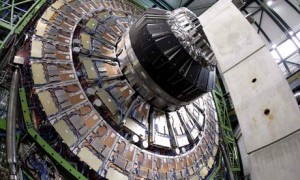
Huh?
OK, let me explain, it is all about what the numbers tell them.
- four-sigma = 1 in 30,000 chance they’ve made an error
so we are not done yet, they still need to get to five-sigma. Thats a 1 in 3 million chance of being wrong (because the probability reduces exponentially).
So will they announce a four-sigma? Well let me put it this way, they have invited along the team who first proposed the idea of the Higgs boson 48 years ago … no doubt to tell them that they have “not” discovered it? Nope, I think not, this indeed looks like we are about to hit a huge milestone in human history, and tomorrow is the day.
“This is the most exciting week in physics history” – theoretical physicist Joe Lykken of Fermilab.
The scientists at Tevatron (Fermilab in the US) say they have come close to proving particle’s existence, and hope Cern will announce firm results. They announced that yesterday.
If all this confuses you and you have no idea what the big deal here is, then here is a nice quick summary …
What is the Higgs boson? Named after Peter Higgs, an Edinburgh University physicist, the Higgs boson is crucial to understanding the origin of mass. Shortly after the big bang, it is thought that many particles had no mass, but became heavy later on thanks to the Higgs field. Any particles that interact with this field are given mass. The Higgs boson is the signature particle of the field.
What exactly is the Higgs field?
A theoretical, invisible energy field that stretches throughout the universe. It clings to fundamental particles wherever they are, dragging on them and making them heavy. Some particles find the field more “sticky” than others. Particles of light – photons – are oblivious to it. Other particles have to wade through it like an elephant in tar. So, in theory, particles can weigh nothing, but as soon as the field switched on shortly after the big bang, they got their mass.
Why do people call it the ‘god particle’?
Its theistic nickname was coined by Nobel prizewinning physicist Leon Lederman, but Higgs himself is no fan of the label. “I find it embarrassing because, though I’m not a believer myself, I think it is the kind of misuse of terminology which I think might offend some people.”
According to Higgs, it wasn’t even Lederman’s choice to call it the god particle: “He wanted to refer to it as that ‘goddamn particle’ and his editor wouldn’t let him.”
What would finding the Higgs boson mean for physics?
It would vindicate the so-called Standard Model of physics which envisages that the universe is made from 12 basic building blocks called fundamental particles and governed by four fundamental forces. The existence of the Higgs boson is predicted by the Standard Model but it has yet to be found by experiments. Even if the Higgs is discovered, the Standard Model does not explain everything.
You can read more about the menagerie of particles predicted by the Standard Model here.
So if indeed we get a Higgs discovery, and I’m currently confident that we will get a 4-sigma, then it would prove that there is an invisible energy field that fills the vacuum throughout the observable universe.
Rumors and inside insights
- The “Not Even Wrong” blog, by physicist Peter Woit has assembled the scientific rumours so far about what Cern might be in a position to announce.
- Philip Gibbs is talking here about a 4.4 sigma … this is what he has unofficially posted …
Update: Here is the latest version of the unofficial global Higgs combination with the new results from D0 included. The significance at 125.5 GeV has crept up to 4.4 sigma.
And as a hint of things to come, I note that he also writes on 29th June …
<
blockquote>
the main question they are investigating will switch from “Is there a Higgs Boson?” to “Is it the standard model Higgs Boson?” Already the 2011 data shown during the winter carried signs that the cross-sections for some decay signatures are quite different from the standard model predictions. In particular the digamma rate is high and the WW is very low. Significance levels were not strong but if this is reinforced by the 2012 data people are going to suspect that new beyond-standard-model physics is at play.
</blockquote)